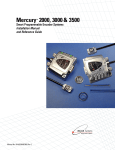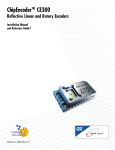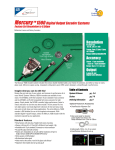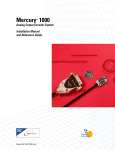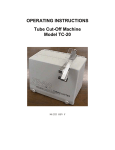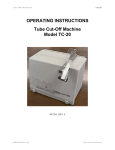Download Mercury 1200 Installation manual
Transcript
Mercury 1200 and 1500P ™ M1200-Analog Output Encoder Systems M1500P-Digital Output Encoder Systems Installation Manual and Reference Guide Manual No. IM-M1200 & M1500P Rev i Introduction MicroE Systems was founded to advance encoder technology to a level never before achieved. Our objective was to design encoder systems that would be small enough to fit into densely packed OEM equipment designs, affordable enough for cost-sensitive applications and easy enough to enable installation, setup and alignment by assemblers with little training. We are pleased to say that all of these goals have been realized with the introduction of the Mercury family of encoders. Sensor shown actual size M10 Precautions 1 Follow standard ESD precautions. Turn power off before connecting the sensor. Do not touch the electrical pins without static protection such as a grounded wrist strap. 2 Do not touch the glass scale unless you are wearing talc-free gloves or finger cots. Please read this installation manual for full instructions. LASER SAFETY INFORMATION: Mercury & ChipEncoder This product is sold solely for use as a component (or replacement) in an electronic product; therefore it is not required to, and does not comply with, 21 CFR 1040.10 and 1040.11 which pertain to complete laser products. The manufacturer of the complete system-level electronic product is responsible for complying with 21 CFR 1040.10 and 1040.11 and for providing the user with all necessary safety warnings and information. MicroE encoders contain an infrared laser diode or diodes. Emitted invisible laser radiation levels have been measured to be within the CDRH Class 1 range, which is not considered hazardous; however, to minimize exposure to the diverging beam, the encoder sensor should be installed in its operational configuration in close proximity to the encoder scale before power is applied. INVISIBLE LASER RADIATION DO NOT VIEW DIRECTLY WITH OPTICAL INSTRUMENTS (MICROSCOPES, EYE LOUPES OR MAGNIFIERS) • Invisible laser radiation; wavelength: 850 nm • Max power 2.4 mW CW (4.8 mW CW for Mercury II™) • CAUTION – The use of optical instruments with this product will increase eye hazard. DO NOT VIEW DIRECTLY WITH OPTICAL INSTRUMENTS (MICROSCOPES, EYE LOUPES OR MAGNIFIERS). • All maintenance procedures such as cleaning must be performed with the MicroE encoder turned off. • Do not insert any reflective surface into the beam path when the encoder is powered. • Do not attempt to service the MicroE encoder. Patents Covered by the following patents: US 5,991,249; EP 895,239; JP 3,025,237; US 6,897,435; and EP 1,451,933. Additional patents and patents pending may apply. Table Of Contents SYSTEM ILLUSTRATION PAGE Encoder with Linear scale 2 Encoder with Rotary scale 3 INSTALLATION INSTRUCTIONS Encoder System Mounting - Linear 4 Encoder System Alignment - Linear 5 Establishing an Index - Linear 5 Encoder System Mounting - Rotary 6 Encoder System Alignment - Rotary 7 Establishing an Index - Rotary 7 REFERENCE SECTION Installation of Linear Scales 8 ENCODER TROUBLESHOOTING Cleaning Scales 9 Contact MicroE Systems 9 Page 1 Mercury 1200 and 1500P Encoder Systems with Linear scale System View Shown with linear scale Sensor head Glass scale (shown mounted on a linear slide) Bracket mounting screws & flat washers Expanded View Optional sensor benching pins (3) Sensor mounting holes (2) Typical user-supplied sensor mounting bracket Detail A Bracket mounting holes (2) Center index mark Mounting screws & Flat washers (2) Scale reference datum; example shown with benching pins Detail A Top reflective linear scale End index mark Scale benching edge Page 2 Mercury 1200 and 1500P Encoder Systems with Rotary scale System View Sensor head Shown with rotary scale Rotary glass scale Expanded View Mounting hole (2) Mounting screws & flat washers Typical user-supplied sensor mounting bracket located here Top reflective rotary scale Index mark Rotary scale Page 3 Installation Instructions Linear Encoders 1 Attach the scale to the base slide. Reference the preferred datum on the interface drawing for either end or center index orientation. Depending on the mounting method, attach the scale to the slide with adhesive. Refer to pg. 8 for details. Be sure the grating surface of the scale faces the sensor. There is to be no contact between these surfaces or damage may result. 3 Be sure power is off before connecting the sensor. Connect the M1200 or M1500P to your interface electronics using the pinout diagram described on the interface drawing. Power up the system. 2 Install the sensor on your mounting surface referencing the appropriate datum surface as shown on the interface drawing. A) Benching pins to locate the sensor may be used if the system mechanical tolerances are adequate. B) Tighten the sensor mounting screws and leave the mounting bracket screws loose to allow sensor head alignment. Page 4 Installation Instructions Linear Encoders 4 MAIN TRACK ALIGNMENT If benching dimensions cannot be provided, proper sensor alignment may require minor adjustments to the sensor head position with respect to the scale. This can be performed by maximizing the sine/cosine signals from the M1200 or M1500P. Using an oscilloscope in the X/Y mode, monitor the sine/cosine signals (refer to the interface drawing for pinouts) while moving the sensor head. Align the sensor until 0.80 volts peak-to-peak +/- 20% is obtained. Tighten the mounting bracket screws. INDEX TRACK ALIGNMENT The M1200 or M1500P must be aligned for both the main and index tracks. When properly aligned, the sensor will produce an index window as the sensor head passes over the index mark. The index window is roughly one fringe wide (20µm). To verify proper index track alignment, use a digital oscilloscope triggered on the index window. Refer to the interface drawing for the index window pinout. 0.80 v Single Ended Lissajous pattern as seen on a scope 5 Confirm proper alignment over the full range of motion. If not aligned over the entire range of motion, loosen the sensor mounting bracket and repeat step 4. θz Y X To align the sensor head, move it in the Y or θz directions. Page 5 Installation Instructions Rotary Encoders 1 Attach your hub/scale assembly to the rotary device. Refer to the interface drawing. The reflective surface of the scale must face the sensor. 3 Be sure power is off before connecting the sensor. Connect the M1200 or M1500P to your interface electronics using the pinout diagram described on the interface drawing. Power up the system. 2 Install the sensor on your mounting surface referencing the appropriate datum surface as shown on the interface drawing. A) Benching pins to locate the sensor may be used if the system mechanical tolerances are adequate. B) Tighten the sensor mounting screws and leave the mounting bracket screws loose to allow sensor head alignment. Page 6 Installation Instructions Rotary Encoders 4 MAIN TRACK ALIGNMENT If benching dimensions cannot be provided, proper sensor alignment may require minor adjustments to the sensor head position with respect to the scale. This can be performed by maximizing the sin/cosine signals from the M1200 or M1500P. Using an oscilloscope in the X/Y mode, monitor the sin/cosine signals (refer to the interface drawing for pinouts) while moving the sensor head. Slowly move the sensor head by allowing it to slide on the mounting surface until 0.80 volts peak-to-peak +/- 20% is obtained. Tighten the mounting bracket screws. INDEX TRACK ALIGNMENT The M1200 or M1500P must be aligned for both the main and index tracks. When properly aligned, the sensor will produce an index window as the sensor head passes over the index mark. The index window is roughly one fringe wide (20µm). To verify proper index track alignment, use a digital oscilloscope triggered on the index window. Refer to the interface drawing for the pinout. 0.80 v Single Ended Lissajous pattern as seen on a scope 5 Confirm proper alignment over the full range of motion. If not aligned over the entire range of motion, loosen the sensor mounting screws and repeat step 4. θz X Y To align the sensor head, move it in the X, Y or θz directions. Page 7 Reference Section Installation of Linear Scales Positioning the Scale Note: Before beginning mounting procedure, use talc-free gloves or finger cots to handle the scales. "Benching" the scale to the system means aligning the scale by means of benching pins. Pin locations are described on the appropriate interface drawing. Two benching pins are recommended on the long side of the scale and one at the end as shown . This is marked datum A on the interface drawing. the benching pins in from either end. 20% of the overall 1 Position scale length is the recommended location from the edge. sure the benching pins do not extend too high in the Z direction to 2 Beprevent mechanical interference with the sensor or sensor mount. 0.2L 0.6L L 0.2L End Benching Pin MicroE Systems Benching pins Mounting the Scale MicroE Systems' linear scales should be affixed to the mounting surface. Two different approaches are described below: Epoxy and RTV Mounting (Recommended for best accuracy) 1 End Benching Pin Make sure the mounting surface is clean and dry. Mounting clamp Hard epoxy at one corner, this end only. scale clamps may be used to secure the 3 Optionally, scale while the adhesive cures. Avoid damage to Scale clamp with adhesive the top surface. L Mounting clamp MicroE Systems Mounting clamp Side view showing optional scale clamps and scale. Space clamps every 75mm on scales over 150 mm in length. RTV around entire outside edge of scale. Benching pins 2 Align the scale by placing the edges against the benching pins. a hard epoxy, such as Tra-Con’s Tra-Bond 2116, to the end of the scale at the end benching pin. Apply 100% Silicone RTV adhesive 4 Apply around the edges of the scale. This method allows thermal expansion from the benched end of the scale. After adhesive curing, remove the scale mounting clamps or, if permanently installing clamps, make sure they do not interfere with the sensor or sensor mount. Two Sided Adhesive Tape Mounting Gently place the scale on the mounting surface. Positioning adjustments Make sure the mounting surface is clean and dry. Peel the be made until the scale is firmly pressed down. After final positioning, 1 cover paper off and place the scale above the final location. 3 can push down on the top of the scale to secure it. End Benching Pin Hard epoxy at one corner, this end only. L MicroE Systems Benching pins 2 Align the scale by placing the edges against the benching pins. Page 8 Cleaning scales General Particle Removal Blow off the contamination with nitrogen, clean air, or a similar gas. Contamination Removal Use a lint-free cleanroom wipe or cotton swab dampened with isopropyl alcohol or acetone only to wipe the surface clean. Handle the scale by the edges. Do not scrub the scale. Contact MicroE Systems Thank you for purchasing a MicroE product. You should expect the highest level of quality and support from MicroE. If you have any questions or want to download the Mercury Encoder Installation Manual, Data Sheet or Interface Drawing, browse www.microesys.com and click on the appropriate product button. You’ll find everything you need right there. World Headquarters: 125 Middlesex Turnpike • Bedford • MA 01730 USA www.microesys.com • [email protected] • T. [781] 266-5700 • F. [781] 266-5112 © 2008 MicroE Systems











